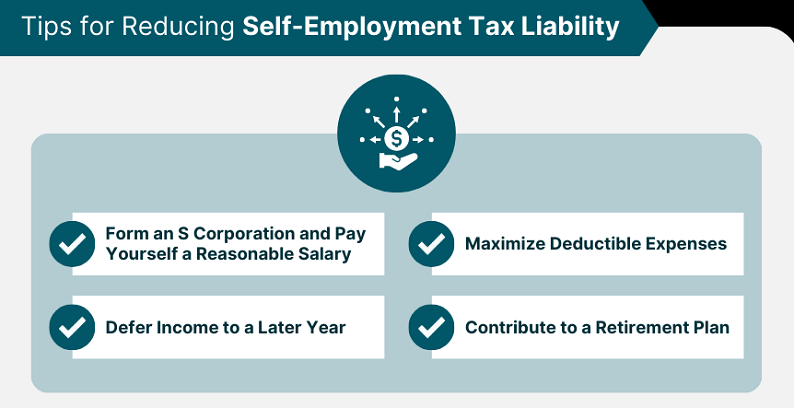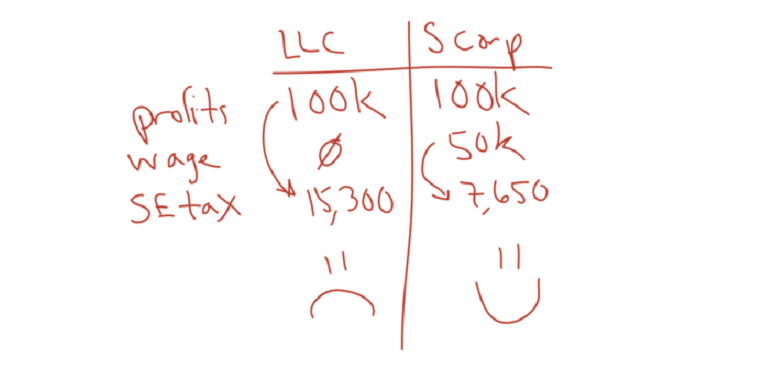
When it comes to running a small business, navigating the complexities of taxation can be a daunting task. One particular tax-related decision that can significantly affect your bottom line is choosing the right business structure. Among the many options available, the S-Corporation (S-Corp) stands out for its unique impact on self-employment taxes. Here we examine what self-employment taxes entail and the advantages and requirements of S-Corporation status.
Contents
- Understanding Self-Employment Taxes
- What is an S-Corporation?
- Impact of S-Corporation Status on Self-Employment Taxes
- Requirements and Limitations of S-Corporation Taxation
- Choosing the Right S-Corporation Status
- References
Understanding Self-Employment Taxes
Small business owners wear many hats, from CEO to janitor, but there’s one role they can’t escape: taxpayer. Understanding your tax obligations is crucial for the financial health of your business, and self-employment taxes are a significant part of that equation.
Explanation of Self-Employment Taxes
Self-employment taxes are a category of taxes that apply to individuals who work for themselves, including sole proprietors, freelancers, and small business owners. Unlike employees who have payroll taxes (Social Security and Medicare) withheld by their employers, self-employed individuals are responsible for paying these taxes themselves.
Self-employment taxes are often referred to as SECA taxes, which stands for the Self-Employment Contributions Act. SECA taxes serve a similar purpose to FICA taxes (Federal Insurance Contributions Act), which apply to employees, but self-employed individuals pay both the employer and employee portions.
Calculation of Self-Employment Taxes
Calculating self-employment taxes involves understanding the components and rates involved:
- Social Security: As of our last knowledge update in September 2021, self-employed individuals pay a 12.4% Social Security tax on their net earnings. This tax funds retirement benefits.
- Medicare: Self-employed individuals also pay a 2.9% Medicare tax on their net earnings. Half of this tax is typically deductible as a business expense.
- Additional Medicare Tax: If your income exceeds a certain threshold (e.g., $200,000 for individuals), you may be subject to an additional 0.9% Medicare tax.
- Net Earnings: To calculate your self-employment tax, you start with your net earnings, which is your business income minus allowable business expenses.
- Quarterly Estimated Payments: Since self-employed individuals don’t have taxes withheld from a paycheck, they are required to make quarterly estimated tax payments to cover their income and self-employment taxes.
Significance for Small Business Owners
Understanding self-employment taxes is vital for small business owners for several reasons:
- Budgeting: You need to budget for these taxes since they aren’t automatically withheld from your earnings.
- Quarterly Payments: Complying with quarterly estimated tax payments is essential to avoid penalties and interest.
- Tax Planning: Self-employment taxes can be a significant part of your overall tax liability, so effective tax planning is crucial to minimize your tax burden.
- Retirement Planning: Contributions to Social Security through self-employment taxes can affect your future Social Security benefits.

What is an S-Corporation?
Understanding the fundamentals of this business structure is essential for making informed decisions about your tax strategy and organizational structure.
Definition and Benefits of S-Corporation Status
An S-Corporation, often referred to as an S-Corp, is a type of business entity that combines the limited liability features of a corporation with the pass-through taxation of a partnership or sole proprietorship. This means that S-Corps provide personal liability protection for their shareholders (owners) while allowing business income and losses to “pass through” to the individual shareholders’ tax returns. Key benefits of S-Corporation status include the following [1].
Limited Liability
Shareholders are typically not personally liable for the business’s debts and legal obligations, protecting their personal assets.
Pass-Through Taxation
S-Corps avoid double taxation. Business profits and losses are passed through to shareholders, who report this income on their individual tax returns, avoiding the corporate income tax.
Avoidance of Self-Employment Tax
S-Corp shareholders can potentially reduce their self-employment tax liability, a significant advantage for small business owners.
Attractive to Investors
S-Corporation status can make it easier to attract investors since it allows for a more straightforward distribution of profits and losses.
Eligibility Criteria for S-Corporation Election
Not all businesses can elect S-Corporation status. To qualify, a business must meet specific criteria [2].
Domestic Entity
The business must be a domestic corporation or LLC (Limited Liability Company).
S-Corps can have no more than 100 shareholders. These shareholders must be individuals, certain trusts, or estates, but not other corporations or partnerships.
One Class of Stock
S-Corps can have only one class of stock, which means all shareholders have the same rights to distributions and liquidation proceeds.
Shareholders must be U.S. citizens or residents.
How S-Corporations Differ from Other Business Structures
It’s essential to distinguish S-Corporations from other common business structures.
C-Corporations
Unlike S-Corps, C-Corps are subject to double taxation – first at the corporate level and then at the individual level when shareholders receive dividends.
Limited Liability Companies (LLCs)
While LLCs also offer limited liability, they are not subject to the same strict eligibility criteria as S-Corps and offer more flexibility in terms of management and taxation.
Partnerships
Partnerships, like S-Corps, pass through income to individual partners, but they do not have the same limited liability protection.

Impact of S-Corporation Status on Self-Employment Taxes
Now that we have a solid understanding of self-employment taxes and what an S-Corporation is, it’s time to explore how choosing S-Corporation status can significantly influence your self-employment tax liabilities.
Pass-Through Taxation in S-Corporations
One of the most compelling aspects of S-Corporation status is its taxation method. S-Corps are “pass-through” entities, which means that the business itself does not pay federal income tax at the corporate level. Instead, profits and losses flow through to the individual shareholders’ personal tax returns [3].
Avoiding Double Taxation
The avoidance of double taxation is a game-changer for many small business owners. Here’s how it works.
C-Corporations vs. S-Corporations
In a traditional C-Corporation, the company pays corporate income tax on its profits. When dividends are distributed to shareholders, they are taxed again at the individual level. This double taxation can significantly reduce the after-tax profits available to shareholders.
S-Corporations and Pass-Through Taxation
In an S-Corporation, there is no corporate income tax. All profits and losses “pass through” to the shareholders, who report these amounts on their personal tax returns. This means that profits are taxed only once, at the individual level.
Reduction in Self-Employment Tax Liability
The real magic of S-Corporation status is in how it can potentially reduce self-employment tax liability. Here’s how it works.
Self-Employment Tax for Sole Proprietors and Partners
Self-employed individuals, such as sole proprietors and partners, are subject to the full 15.3% self-employment tax on their net earnings (12.4% for Social Security and 2.9% for Medicare).
Self-Employment Tax for S-Corporation Owners
S-Corporation shareholders who are active in the business often receive a salary for their work. This salary is subject to self-employment tax like any other earned income. However, any profits distributed to shareholders as dividends are not subject to self-employment tax. This means potential tax savings, as you only pay self-employment tax on the salary portion of your income [4].
Reasonable Salary
It’s crucial to establish a reasonable salary to ensure compliance with IRS regulations. Paying too little salary and distributing too much in dividends can trigger IRS scrutiny.

Requirements and Limitations of S-Corporation Taxation
Understanding the requirements and limitations of S-Corporation (S-Corp) taxation is crucial before deciding to elect this tax status for your business.
One of the fundamental requirements for S-Corporation status is the limitation on the number of shareholders.
An S-Corp can have no more than 100 shareholders. This restriction is in place to maintain the close-knit, closely-held nature of S-Corporations.
Family members are generally treated as a single shareholder for the purpose of this rule. This allows for families to have a significant stake in the business without exceeding the 100-shareholder limit [5].
S-Corps are particular about who can be a shareholder.
Individuals and Certain Trusts
Shareholders must be individuals or certain types of trusts, such as grantor trusts. Other business entities, such as C-Corporations and partnerships, are generally not eligible.
Non-Resident Aliens
Non-resident aliens cannot be shareholders in an S-Corporation, limiting the potential for international ownership.
Reporting and Compliance Requirements
S-Corporation status comes with specific reporting and compliance obligations.
Annual Filings
S-Corps must file an annual information return (Form 1120S) with the IRS, detailing income, deductions, and other financial information.
K-1 Forms
Each shareholder receives a Schedule K-1, which reports their share of the S-Corp’s income, deductions, and credits. Shareholders use this information to report their S-Corp income on their individual tax returns.
Proper Record-Keeping
Maintaining accurate financial records and minutes of meetings is essential to demonstrate compliance with S-Corp requirements.
Common Mistakes to Avoid
Navigating the rules and regulations of S-Corporation taxation can be tricky, and small business owners often make common mistakes.
Excessive Distributions
Distributing profits without establishing a reasonable salary for active shareholders can lead to IRS scrutiny and potential reclassification of distributions as salary.
Not adhering to the rules regarding who can be a shareholder can result in the loss of S-Corp status.
Failure to File or Report Timely
Missing filing deadlines or failing to provide accurate K-1 forms to shareholders can lead to penalties and tax issues.
Choosing the Right S-Corporation Status
Selecting the most suitable business structure is a pivotal decision for any entrepreneur. It profoundly impacts your tax obligations, liability, and overall business operations.
Factors to Consider When Deciding on S-Corporation Status
Before making the decision to elect S-Corporation status, reflect on the following factors.
Business Size and Growth Plans
S-Corporations are typically best suited for small to mid-sized businesses. If you anticipate rapid growth or have more than 100 shareholders, other structures like C-Corporations may be more appropriate.
Tax Goals
Consider your tax goals carefully. S-Corporation status can provide tax savings through pass-through taxation, but it may not be the best choice for all situations. Consult with a tax advisor to assess your specific tax needs.
Ownership Structure
If you plan to have a diverse ownership structure, with different types of shareholders (e.g., individuals, other businesses, foreign investors), an S-Corp may not accommodate these structures as well as an LLC or C-Corp.
Salary and Distribution Preferences
Your approach to compensating yourself and other owners can impact your tax liability. If you prefer to minimize self-employment taxes, S-Corporation status may be favorable.
Comparing S-Corporations to Other Business Structures
It’s crucial to compare S-Corporations to alternative business structures to determine the best fit.
C-Corporation
C-Corporations offer flexibility in terms of ownership and stock classes, making them suitable for larger businesses and those seeking venture capital. However, they are subject to double taxation.
Limited Liability Company (LLC)
LLCs combine the liability protection of corporations with the flexibility of partnerships. They are a popular choice for small businesses, as they offer pass-through taxation and fewer regulatory requirements than S-Corps.
Partnership
Partnerships are ideal for businesses with multiple owners who prefer to allocate profits and losses according to their ownership interests. However, they do not provide personal liability protection to partners.
Consultation with Tax Professionals
Ultimately, the decision of whether to elect S-Corporation status should be made in consultation with tax professionals who understand your unique circumstances. Tax advisors can help you analyze your financial goals, business structure preferences, and long-term plans to make an informed choice.
References
[1] S Corp and Self Employment Tax: What you need to know
[2] Do Officers of an S-Corp Pay Self-Employment Tax?
[3] If You Are Self-Employed
[4] S corporations
[5] How an S Corporation Pays Taxes
